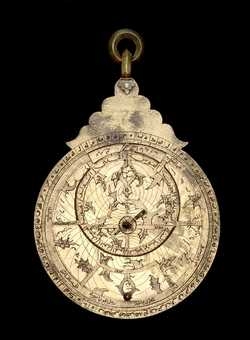| Date | late 16th or early 17th century |
| Place | Persia (?) |
| Material | Brass |
| Inventory no. | 47063 |
| Acquisition | Lent by the Bodleian Library, Oxford, in 1952 |
William Laud (1573-1645), Archbishop of Canterbury and Chancellor of Oxford University, owned two astrolabes, both of which are now in the collection. In the 1630s he gave both of them to Oxford institutions: his European one by Georg Hartmann (inventory number 38642 [ID 227]) to St John's College, of which he had been President; and his Islamic one (this one) to the Bodleian Library. Both bear his coat of arms impaled by the arms of Canterbury.
Gifts of this kind were important tokens of patronage and power. But Laud was also concerned, along with contemporaries like Selden and Savile, to expand Oxford's academic horizons, by promoting both mathematical studies and interest in oriental language and culture. The Bodleian astrolabe is believed to have been given to Laud by John Selden, whose own astrolabe also came to the Bodleian Library (inventory no. 37527).
Laud's astrolabe, however, compared for instance to Selden's, is not a particularly impressive example. It is rather coarsely made and of no great antiquity, and if not a poor western copy may be an early example of astrolabes made to low standards in parts of the Islamic world (such as the ports of North Africa) for sale to European travellers.
View all
images for this astrolabe
View
detailed provenance for this astrolabe
Mater
The mater and limb are of one-piece construction. The tab that holds the tympans in place is located at the throne.. Scales on the limb: degree scale. More informationBack
The back contains 8 scales of the following types: Degree; Sine/Cosine; Declination; Shadow square. More informationRete, Pin & Horse
The rete contains 0 stars. The rete is a replacement. The zodiac on the rete is labelled: الحمل , الثور , الجوزا , السرطان , الاسد , السنبله , الميزان , العقرب , القوس , الجدي , الدلو , الحوت .The rete is attached using a pin & horse. The head and tip of the pin is decorated with radial lines. The horse is rather simply carved. Whether or not these are original remains uncertain.. More information



